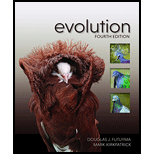
Concept explainers
(a)
To determine: Whether the mutations are non-random since they affect the cell from the environmental stresses.
Introduction: The variations caused by the genetic material of the organisms from a source or randomly are called “mutations”. The mutations affect the constant gene of a species and differentiated the part of the gene in a modified form known as “alleles”. The randomness in the mutation rate was shown by Lederberg in “replica plate experiment”. The minute changes in the “DNA fragment” caused the very new variations among the individuals which makes them different from each other. The mutations are the causative factor of variations in an individual to serve, the purpose of survival and reproduction which transmits from one generation to another.
(b)
To determine: The probability of adaptation by an increase in the rate of mutations.
Introduction: The variations caused by the genetic material of the organisms from a source or randomly are called “mutations”. The mutations affect the constant gene of a species and differentiated the part of the gene in a modified form known as “alleles”. The randomness in the mutation rate was shown by Lederberg in “replica plate experiment”. The minute changes in the “DNA fragment” caused the very new variations among the individuals which makes them different from each other. The mutations are the causative factor of variations in an individual to serve, the purpose of survival and reproduction which transmits from one generation to another.
(c)
To determine: The probability of changes in the cell by an increase in the rate of mutations.
Introduction: The variations caused by the genetic material of the organisms from a source or randomly are called “mutations”. The mutations affect the constant gene of a species and differentiated the part of the gene in a modified form known as “alleles”. The randomness in the mutation rate was shown by Lederberg in “replica plate experiment”. The minute changes in the “DNA fragment” caused the very new variations among the individuals which makes them different from each other. The mutations are the causative factor of variations in an individual to serve, the purpose of survival and reproduction which transmits from one generation to another.
Trending nowThis is a popular solution!

Chapter 4 Solutions
Evolution
- Statistically, are mutations almost always beneficial or harmful? Why?arrow_forwardIf mutations occur at random with respect to an organism’s needs, how does a species become more adapted to its environment over time?arrow_forwardAs discussed, the overall rate of mutations in humans is estimated to be about 1 × 10−8 mutations per base pair per generation. How many new mutations would you expect each person to carry, on average, based on this mutation rate? Other studies have estimated that each person carries about 100 new loss-of-function mutations. How does this number compare with your estimate of the number of mutations based on the mutation rate? What might account for any differences?arrow_forward
- A. What is the pathogen that is attacking bananas today?b. Why is this especially problematic in Africa? C. Why do we expect to lose the war with this pathogen?d. What is random mutagenesis?arrow_forwardUse the information uploaded in the picture to help with this question. Would you conclude that IP-1383 induces mutations or not? Briefly (one or two sentences) explain how or why you came to your conclusion.arrow_forwardIs a random mutation more likely to be beneficial or harmful?Explain your answer.arrow_forward
- DNA sequencing has provided data to indicate that cancer cells may contain tens of thousands of somatic mutations, only some of which confer a growth advantage to a cancer cell. How do scientists describe and categorize these recently discovered populations of mutations in cancer cells?arrow_forwardUsing specific examples that have happened in your lifetime, distinguish between a spontaneous mutation and one that is the result of exposure to a substance or radiation.arrow_forwardWhat is the difference between the mutation rate and the mutation frequency?arrow_forward
 Human Heredity: Principles and Issues (MindTap Co...BiologyISBN:9781305251052Author:Michael CummingsPublisher:Cengage Learning
Human Heredity: Principles and Issues (MindTap Co...BiologyISBN:9781305251052Author:Michael CummingsPublisher:Cengage Learning
